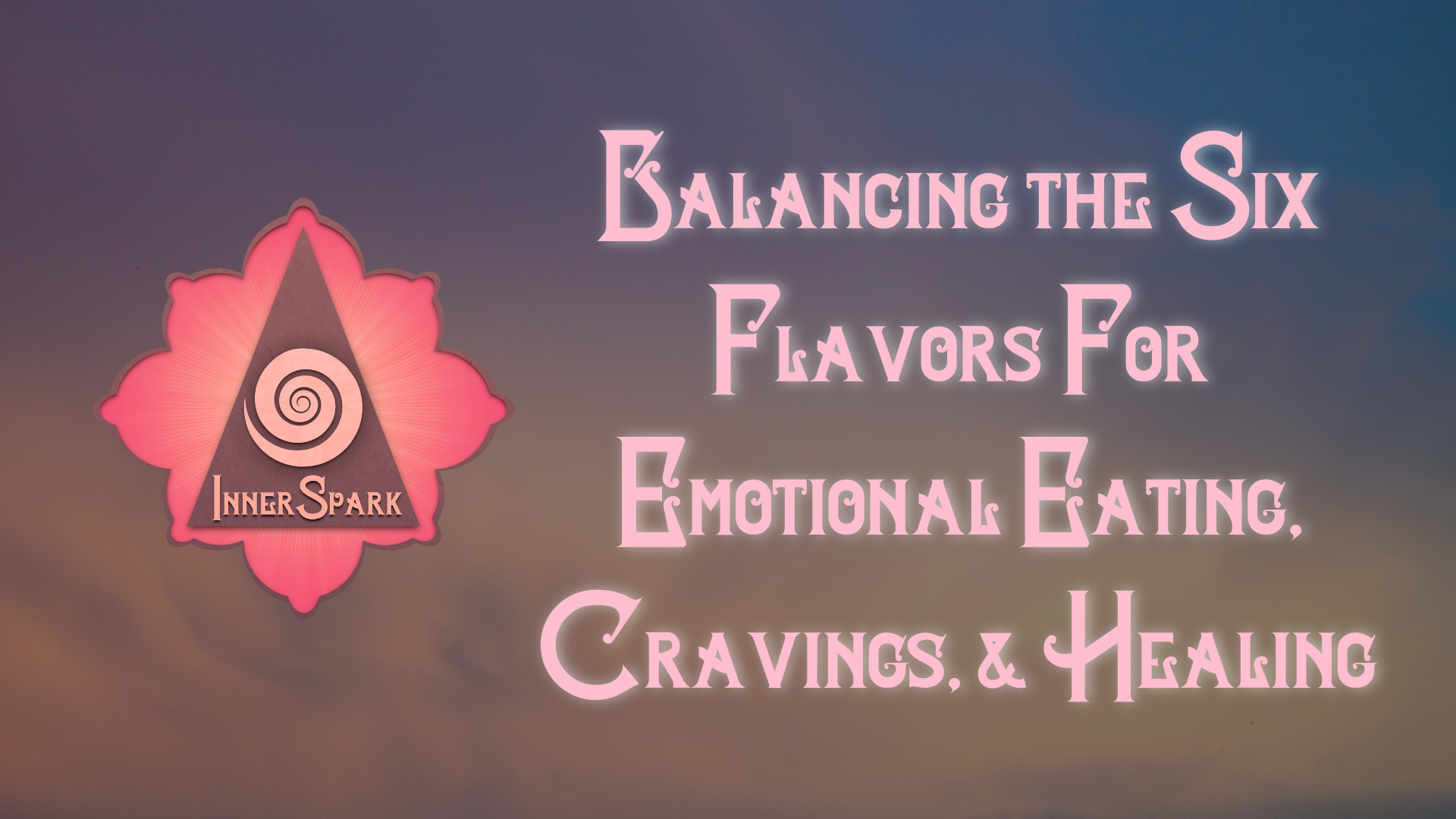The flavors, in particular the six main ones as recognized by Ayurveda, contribute to our entire experience of life. Each one has it’s own energetic signature and effect on the system as a whole and today we’re going to explore how these six tastes – sweet, sour, salty, bitter, pungent, and astringent – impact us, how to bring balance, specific examples of each, and more! Let’s dive in!
Powered by RedCircle
Introducing the Six Tastes
The six tastes are: sweet, sour, salty, bitter, pungent, and astringent. Each taste has a unique effect on our body and mind.
In Ayurveda, the six tastes are considered crucial for our health and well-being. Each taste has its unique effect on the body and mind, and balancing these tastes in our diet can help us maintain physical and emotional equilibrium.
The Six Tastes and Their Effects
Sweet: Examples include grains, dairy, certain fruits, and natural sweeteners like honey. Sweet taste nourishes and revitalizes the body, promotes strength, and calms the nerves. However, excessive consumption can lead to weight gain, lethargy, and congestion.
Sour: Examples are citrus fruits, fermented foods, and vinegar. Sour taste stimulates appetite and digestion, energizes the body, and sharpens the senses. Overindulgence can cause acidity, heartburn, and disturb the natural balance of bodily fluids.
Salty: Common sources are sea salt and saline foods. Salt enhances taste, stimulates digestion, and maintains mineral balance. Excess salt intake can lead to high blood pressure, bloating, and skin issues.
Bitter: Leafy greens, turmeric, and coffee are examples. Bitter taste detoxifies the body, supports weight loss, and combats inflammation. However, too much bitterness can deplete tissues and induce dryness.
Pungent: Chili peppers, ginger, and onions. Pungent taste stimulates digestion and metabolism, clears the sinuses, and promotes sweating. Overuse can lead to irritation and inflammation in the digestive tract.
Astringent: Beans, green apples, and tea. Astringent taste helps absorb water, tightens tissues, and dries fats. In excess, it can cause dryness and constipation.
Think about your diet and your baseline experience of your body, mind, and emotions. Are you experiencing a lot of constipation, perhaps irritation and anger… now reflect on the main flavors of your diet and begin to connect the dots. It’s really awesome and really empowering to realize we can make changes and have an entirely different experience! Cause and effect is a wonderful thing!
The Emotional Connection
Our diet influences more than just physical health; it impacts our emotions too. Cravings for sweets, for instance, often signal a need for comfort or grounding. Recognizing this allows us to meet our true needs rather than reaching for temporary fixes.
Cravings and Imbalances
When we’re out of balance, the notion of “intuitive eating” becomes skewed. Imbalances can manifest as cravings for foods that perpetuate our current state rather than bring us back to equilibrium.
True hunger seeks nourishment from any wholesome food, whereas cravings often demand specific tastes or foods that may not serve our overall health. True hunger can be satisfied with wholesome food and doesn’t necessarily strongly demand specific flavors or foods like the way a craving does. When a system is imbalanced, cravings can’t necessarily be trusted as authentic cues from the within that are trying to guide one towards greater balance.
Subtle cues, not strong cravings, are your body’s way of bringing balance. Balance isn’t a fixed, rigid destination, but a spectrum we dance along each day, each season, throughout our life. Recognizing the difference between a craving and a subtle cue from our body is key to restoring balance.
Seasonal eating plays a pivotal role here, aligning our diet with the energy of the current season enhances our body’s natural healing processes and brings our system into balance as each season contains its own specific effect and energy. Ever notice how a watermelon may not sound as appealing in the middle of January as it does in the middle of July?
Balancing Tastes for Emotional Well-being
Incorporating all six tastes in our meals promotes emotional stability and satisfaction. For example, a balanced meal might include a base of sweet grains and sweet potato, a legume for its astringent properties, kale for its bitterness, cooked with spices like salt, coriander, ginger, turmeric.
Balancing tastes can lead to emotional stability and satisfaction, optimum digestion, clarity, resilience, joy, and vitality! Our food is meant to sustain and nourish and energize us. Let’s give it the right conditions so it may do its job and so we may reap the full benefits!
Alex’s Story
Let me share the story of Alex, who came to me struggling with emotional eating and a tumultuous relationship with food. By introducing a balanced array of the six tastes into their diet, Alex began to notice a shift. Sweet grains and fruits provided comfort without the crash of processed sugars. Incorporating sour tastes sparked Alex’s digestive fire, enhancing their overall digestion and zest for life. Salty tastes, used in moderation, brought out the depth in meals, satisfying cravings in a healthy way. Bitter greens helped detoxify Alex’s body, leading to clearer skin and reduced inflammation. Pungent spices ignited Alex’s metabolism, bringing warmth and vitality. Lastly, the astringent taste helped Alex feel fuller longer, reducing incessant snacking.
Through this journey, Alex not only found a way to eat that supported their physical health but also healed their emotional relationship with food. The balance of the six tastes became a foundation for Alex’s newfound vitality and emotional stability, proving the transformative power of Ayurvedic principles on overall health.
Emotional and Spiritual Aspects of Eating
What is your relationship with food and eating?
Eating is an emotional and spiritual act as well. Mindful eating practices, such as savoring each bite and expressing gratitude for our food, can actually deepen the nourishment we receive from it! It’s also a practice in self-love and honoring our bodies.
A simple, yet profound practice is pausing to take some breaths before you begin eating. Let yourself reflect on the food before you, all of the sunglight, moon beams, water, soil, microorganisms, people and everything in between that played a part in bringing it to your plate.
Feminine Shame & Eating
I want to touch on Feminine Shame here, the phenomenon I’ve observed and named that is a resistance towards and a fear and disdain of that which is natural, cyclical, wholesome, tender, changing, soft. It’s a shame towards that which is natural in a world trying to get us on board with what’s normal at the expense of our physical, emotional, mental, spiritual, and relational well-being.
Feminine shame often ties into how we relate to food and our bodies, marked by feelings of guilt for eating certain foods or for not adhering to societal beauty standards. This shame can disrupt our relationship with food, leading us to ignore our body’s wisdom in favor of external dietary trends that may not align with our intrinsic needs. Healing this aspect involves recognizing and honoring our body’s cues without judgment and allowing ourselves to enjoy a harmonious relationship with food and eating.
Conclusion
Balancing the six tastes invites us to connect with our body’s wisdom and to discover the joy of eating in a way that supports our whole being. Start experimenting in your kitchen and notice how these adjustments affect your mood, energy, and health.
Today, we’ve explored how the six tastes affect our health and emotions, the importance of seasonal eating, and the power of mindful eating.
Food is powerful; it shapes literally everything in our life – our experiences, our health, our mind, our energy, our emotions. Embrace the art of balanced eating to transform your life. Remember, the journey to well-being is both delicious and profound.
Thank you for joining me on this flavorful exploration. I’d love to hear how balancing the six tastes transforms your health and happiness. If you’re seeking personalized guidance, I’m here to help with tailored strategies for embracing Nature’ wisdom in your life. Until next time, nurture your InnerSpark and let it guide you to your fullest potential.
The InnerSpark Method
Timeless Wisdom to become Naturally Resilient
Transform life's storms and cultivate peace, resilience, and vitality with Nature's wisdom.
Dive deep into nature’s rhythms, unraveling from the complexities and strains of modern life, and align yourself with the ebb and flow that has sustained life for millennia.
Drawing from nature, our eternal mentor, we glean lessons of steadfastness, flow, and unity.
But as the digital age surges forward, our intimate connection to these timeless rhythms is diminishing, causing our physical, emotional, mental, relational, and spiritual well being to teeter.
The InnerSpark Method bridges that gap, guiding you back to your innate resilience and rhythm, reigniting your zest for life and sense of purpose.
Come discover a whole-person, trauma-informed system of Nature's self-care to rekindle natural cadences across all dimensions of your being - whether it's the physicality of daily routines, the depths of emotional resilience, the realms of mental clarity, the vibrations of energy, the art of relationships, or the ethereal world of spirituality.
More Holistic Living + Healing:
-

Nature’s Medicine Bag
Physical body and life challenges are simply the manifestation of dysfunctions at the subtle level of your being.
-

Ayurveda For Stress
In modern life, the impacts of stress increasingly dictate our experiences. Turning to Ayurveda for stress and other modern ailments can help us reconnect with nature’s rhythms and cultivate resilience. Ayurveda: The Science of Life & Wholeness Translated as “the science of life,” Ayurveda is a 5,000-year-old healing tradition from India. This system emphasizes balance,…



0 Comments